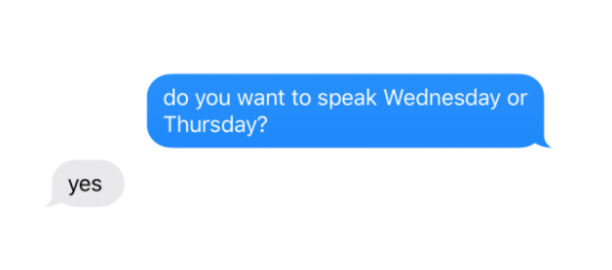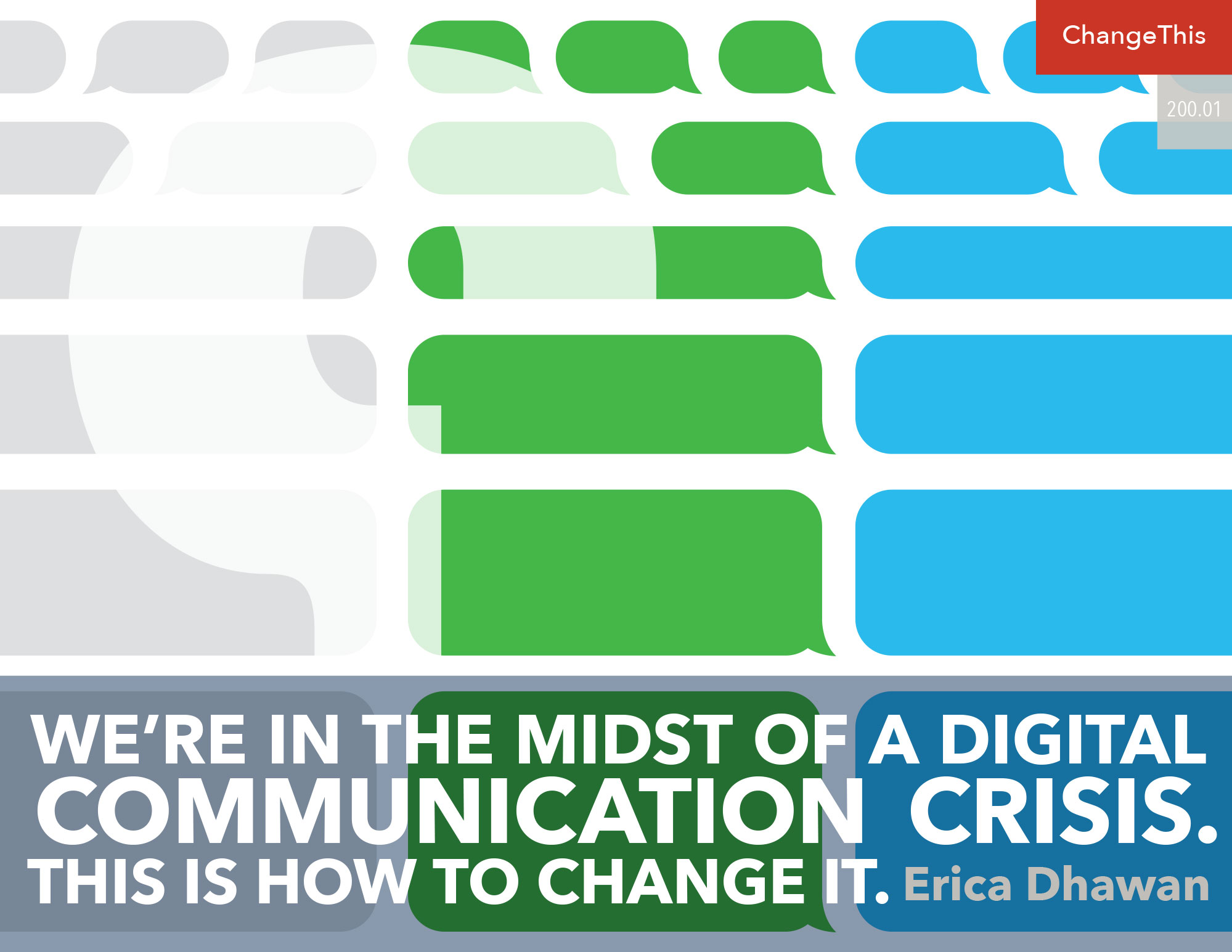We’re In the Midst of a Digital Communication Crisis. This Is How to Change It.
Digital communication can be exhausting.
Isn’t it all—everything from texting to emails to video calls—meant to save us time and strengthen our relationships with one another?
I recently ran a 2,000 person research study of office workers and found that on average, each individual is actually wasting four hours per week on poor, unclear, or confusing digital communication. This costs up to 889 billion dollars per year in the US alone.
When people ask why I’ve devoted my career to research on digital body language, I tell them it’s a story that’s defined my entire life.
As a first-generation American born to Indian parents, I came to English in an indirect way. I grew up in a middle-class neighborhood. At home, my parents spoke mostly Punjabi—a language native to the Northern region of India where my family originated. We rarely spoke English at home. Which meant that when I got to school, I struggled with fitting in.
There weren’t many girls who looked like me in suburban Pittsburgh in 1992, nor were there many immigrant families in my neighborhood at all. And at the same time, I felt I wasn’t Indian enough for my Indian relatives—how many Indian women do you know named ERICA?
This is a common story for children of immigrants. But caught between two cultures, I simply chose to retreat. I was shy, quiet, more an observer than a participant. Little did I know I’d end up speaking on some of the world’s largest stages.
As a young girl, I developed a few tactics to figure out what was going on when I couldn’t understand what was being said—either in English or in Punjabi. One of those tricks was deciphering body language.
I became obsessed with decoding my classmates’ signals and cues, no matter how subtle. Tone, pacing, pauses, gestures. The popular girls walked around me with their heads high, shoulders pulled back, almost literally looking down on the rest of us. The older kids showed their disinterest by slouching during school assemblies, their eyes turned to the ground or each other—never to the adult speaking.
And there is one moment in my childhood that stands out immensely in… let’s call it my “relationship” with body language. This is a story I’ve never shared until now.
After 9/11 in the United States, everyone who looked like me was treated with instant suspicion in public spaces. I was 16 years old. My father came to pick me up from a tennis practice at the local community center. Someone behind the front desk saw him waiting at the entrance and called the police—he looked ‘suspicious’ to them. And so, the police came and, for the next 45 minutes, my father fielded questions from the officers, politely explaining that he worked as a cardiologist at a nearby hospital. I looked on as he stood behind a table, speaking patiently with the officers as they frisked him—his eye contact direct, his palms wide open, signaling his respect to the officers and his understanding of why this was happening. I saw his flushed cheeks. I knew he was embarrassed.
My heart was racing, and I was angry—angry at the police for making me feel like we had done something wrong, and angry at my father. How could he respond with kindness and respect to what I saw as ignorance and racism? Later, my father explained to me that body language had saved his life that day. That was an inflection point for me, a day I began thinking deeper about how humans connect using body language.
As I continued on my journey towards my career, I saw clearly that humans rely on body language to build trust. But there was a disconnect—the more we infused technology into our daily lives (both at work and at home), the less we were able to see the body language of the people we were trying to connect with.
Before the pandemic, 70% of team collaboration was digital—emails, text messages, collaboration platforms. During the pandemic, that number shot up to 100% for all teams that had the capabilities to do so.
Yet teams are suffering from increased miscommunication, work-related anxiety, and digital confusion. Why? It’s because body language hasn’t disappeared. But it has transformed. Let me tell you how.
Misunderstandings are rampant in today’s workplaces. And while poor communication habits may feel inevitable with colleagues, we should always strive to engage with clarity and empathy, especially as we come to rely more on remote work and digital communication. A good first step to improving our habits? Re-learning what it means to read carefully and write clearly.
Not so long ago, we shared information with our colleagues across a table or by phone line, listening to people’s ideas and responding accordingly. Today, so many of those exchanges happen in written (or typed) form—think email, text, IM—meaning that listening in its traditional sense has been replaced by reading text on a screen. The problem with this, according to the linguist Naomi Baron, is that we comprehend less when we read on a screen than we do when we read print; we devote less time to reading something in full, and tend to skim and search for key takeaways. On the other end, we come to feel so burdened by the volume of emails we have to write that we end up sending sloppy or terse or confusing responses.
We like to think that reading and writing comprehension is the stuff of high school English classes, but given how central the skillset is to our virtual lives, reminding ourselves what good communication looks like is critical to being a conscientious colleague. Since most of us communicate most of the time with our thumbs, we need new rules of thumb to help us become better readers and communicators.
IS LESS REALLY MORE? DON’T RUSH TO PROVIDE AN ANSWER!
We’d like to think that executive leaders are always calculated and careful in their communication, that they double-check all of their written digital messages, and treat their virtual interactions as if they’re happening in person. But our executive leaders are often the worst when it comes to sending thoughtful responses, and their teams can suffer from it.
 Brevity from the upper echelons of power isn’t exactly uncommon. Sloppy texts and sloppier emails, poor sentences, bad grammar, atrocious spelling—we don’t have time to care! At Morgan Stanley, there was a running joke that the more senior you were, the fewer characters you needed to express your gratitude in a text or email. You started your career with “Thank you so much!” and after a promotion or two, this was cut down to “Thanks.”
Brevity from the upper echelons of power isn’t exactly uncommon. Sloppy texts and sloppier emails, poor sentences, bad grammar, atrocious spelling—we don’t have time to care! At Morgan Stanley, there was a running joke that the more senior you were, the fewer characters you needed to express your gratitude in a text or email. You started your career with “Thank you so much!” and after a promotion or two, this was cut down to “Thanks.”
Brevity can make a person appear important, but it can also hurt your business. Getting a slapdash email means that the recipient has to spend time deciphering what it means, causing delays and potentially leading to costly mistakes. And, according to Danielle Gunraj, a professor of psychology at Binghamton University, when we use the punctuation we associate most with brevity—the dreaded sentence-final period—we come across as insincere.
One executive who I’ll call Tom was renowned in our office for both carelessness and his brevity. Once, when a direct report sent him an email, asking, “Tom, do you want us to move forward with this plan or should we gather more information?” Tom replied, “yes.” Thanks, Tom, we’ll move ahead on one, or both, or neither. Imagine how much time his team wasted debating how long they had to wait before someone pointed out to him he hadn’t answered the question!
Leadership expert Dr. Jaclyn Kostner has this to say to execs about sloppiness: “You have to find the time; otherwise, you’re not fit for the job and somebody else should be doing it. Or maybe you need to offload some responsibilities, because there’s no excuse for sending people cryptic emails.” Leaders don’t have to respond to every message, but when important work guidance is required, their communications should at least be clear.
BE TONE-DEFT, NOT TONE-DEAF
Tone—the overall attitude, or character, of a message—is another key component of strong reading and writing skills. Perhaps more than anything else, it’s the greatest tool for communicating empathy. So ask yourself: Who is the recipient? Who is the audience?
One thing I tell my clients who struggle with digital communication is to make sure they keep in mind the visual impact of their message. I’ll explain.
Ethan, a young manager I coach, once told me about an interaction he had with a senior leader that left him feeling unappreciated and belittled. As requested, he had sent this senior leader a detailed plan about increasing productivity among his teams. The plan set forth a different way of working that Ethan was certain could help teams avoid duplicating their efforts and create new levels of transparency. Ethan was excited about the plan, and even included specific questions for the next team meeting. Expecting a positive response, maybe even a few follow-up questions, what he got back from the executive was this: “k.”
Sorry, what? K-what? K-pop? Ethan felt confused and insulted. The visual impact of “k” was that Ethan’s clear and comprehensive proposal hardly deserved a response at all. Was the executive even thinking about Ethan’s plan—or was she dismissing it outright? Did “k” mean she was giving him the green light to proceed, or was it a subtle command to put his dumb idea on a back burner? It was impossible to tell. Also, did the senior leader think so little of Ethan that she couldn’t be bothered to write more than a single letter? Even something pedestrian, like “okay I’ll get back to you,” would have conveyed more respect and attentiveness than that “k.”
 Tone deficiencies like the one Ethan’s boss demonstrated can hurt morale and sew confusion. It’s no surprise that responding to someone’s hard work with a one word (or one letter) response communicates a lack of empathy for the person at the receiving end. Don’t respond for the sake of responding if you don’t have something substantive to offer. If you are having one of those days where you can’t give thoughtful attention to an email, send a quick reply acknowledging you received it, and let them know that you plan to respond to it at greater length as soon as possible.
Tone deficiencies like the one Ethan’s boss demonstrated can hurt morale and sew confusion. It’s no surprise that responding to someone’s hard work with a one word (or one letter) response communicates a lack of empathy for the person at the receiving end. Don’t respond for the sake of responding if you don’t have something substantive to offer. If you are having one of those days where you can’t give thoughtful attention to an email, send a quick reply acknowledging you received it, and let them know that you plan to respond to it at greater length as soon as possible.
RESPONDING CLEARLY SHOWS EMPATHY AND RESPECT
One of the more obvious reasons our reading skills decline at work is that we’re often moving at lightning speed, which makes detail easy to brush over. The thing is, a lot of us aren’t really as busy as we’d like to think we are. And it costs us: our speed, and the anxiety that surrounds it, erodes our commitment to accuracy, clarity, and respect.
Always reference details in your communications. If someone sends you a longer email debriefing about a virtual meeting, respond to specific components of the email rather than sending back a blanket response. It shows that you put in the time to really read through the other person’s time and thinking.
A lot of the time, misinterpreting an email is a question of not understanding a dropped word or punctuation that’s misleading. The solution is simple: proofread your emails before sending them. Take advantage of spell check and other proofreading programs. Proofreading is both a habit and a skill: making it a point of pride to send clean, unambiguous copy will help people take what you write more seriously.
Our speed, and the anxiety that surrounds it, erodes our commitment to accuracy, clarity, and respect.
PICK UP THE PHONE. A PHONE CALL IS WORTH A THOUSAND EMAILS.
With so many written platforms at our disposal, we can also get caught up in asking too many questions in email or group chat. Phone, video, or live meetings safeguard us from asking one tiny question after the next, instead requiring us to formulate the right questions.
A German client once told me, “I was having a never-ending email back and forth with a French and an Indian colleague who were having a circular written dialogue, covering the same ground over and over without understanding each other. I got them both to hop on the phone with me, asked a few questions a few different ways, and we got to the bottom of the issue.”
A good phone conversation is fast becoming an obsolete art. Which is too bad, since a call can save lots of time while simultaneously generating goodwill. (C’mon, we can’t explain everything digitally!)
If you just received a vague or confusing text or email, don’t be afraid to ask to request a phone conversation or, if possible, a video or in-person meeting. If it’s a sensitive dialogue, requesting a quick call shows you’re being thoughtful. Instead of making you look indecisive, waiting a few beats before responding to questions shows the other person that you are listening and taking your work seriously.
Lacking cues like eye contact, tone of voice or body language to clarify what another person means makes digital communication challenging. In lieu of traditional body language, having the skills to read and write carefully is essential to organizations who want to make sure their teams are on the same page and excel in our virtual world.
ABOUT THE AUTHOR
Erica Dhawan is a globally recognized leadership expert and keynote speaker helping organizations and leaders innovate faster and further, together. Erica has spoken, worldwide, to organizations and enterprises that range from the World Economic Forum to U.S. and global Fortune 500 companies, associations, sports teams, and government institutions. Named as one of the top management professionals around the world by Global Gurus, she is the founder and CEO of Cotential—a company that has helped leaders and teams leverage twenty-first-century collaboration skills globally. Her writing has appeared in dozens of publications, including Fast Company and Harvard Business Review. She has an MPA from Harvard Kennedy School, MBA from MIT Sloan, and BS from The Wharton School. Learn more about her on her website ericadhawan.com and follow her @ericadhawan. Join the community at ericadhawan.com/digitalbodylanguage.




